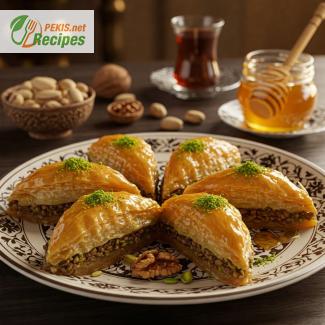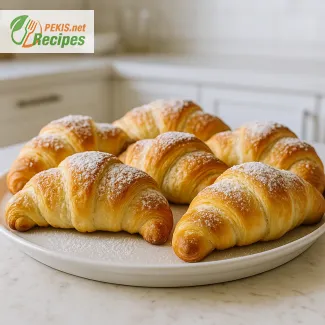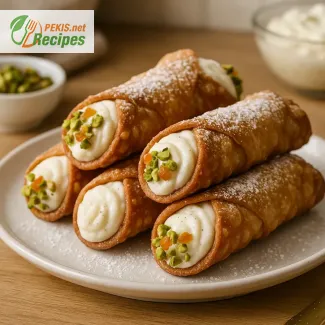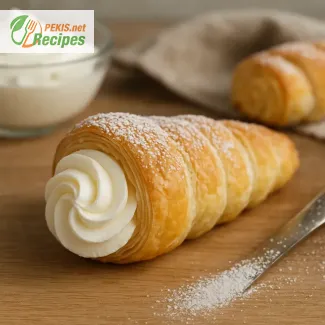
The Irresistible Layers of Baklava: A Timeless Pastry Delight
A centuries-old dessert with a perfect balance of sweetness and crunch
Baklava is an iconic dessert that has delighted taste buds for centuries. With its golden, crispy layers of puff pastry, a rich nutty filling, and a luscious honey syrup, this delicacy embodies the art of fine pastry-making. The moment you take a bite, you are met with a harmonious blend of textures—the crunch of the baked layers, the tender chewiness of the filling, and the silky smooth drizzle of honey that ties everything together.
Though its origins are often debated, baklava is a celebrated dessert across many cultures, from the Middle East to the Mediterranean, the Balkans, and beyond. It is a staple at festive gatherings, symbolizing hospitality, tradition, and indulgence. Whether served during holidays, weddings, or special occasions, baklava is more than just a dessert—it is a culinary experience that has stood the test of time.
The magic behind baklava's delicate layers
At first glance, baklava may seem like an ordinary pastry, but its intricate preparation sets it apart. The foundation of this dessert is filo dough, a paper-thin pastry that turns irresistibly crisp when baked. The key to achieving the perfect texture lies in layering each sheet with melted butter, creating an airy, flaky bite that melts in your mouth.
Between these delicate layers lies a generous filling of crushed nuts, typically walnuts, pistachios, or almonds. The choice of nuts can vary based on regional influences, but each variation brings its own unique richness and depth of flavor. A sprinkle of warm spices such as cinnamon and cloves enhances the aroma, making every bite more indulgent.
Once baked to a golden perfection, baklava is drenched in a fragrant syrup made of honey, sugar, and a touch of citrus. The syrup seeps into the pastry, infusing each layer with a deep sweetness while keeping it moist yet crisp. This final step is crucial—it balances the richness of the nuts and butter with a light, floral sweetness that defines baklava’s signature taste.
A dessert with a rich cultural heritage
Baklava's origins are deeply rooted in history, with influences spanning from Ottoman kitchens to Persian and Greek culinary traditions. Some sources trace its beginnings to ancient Mesopotamia, while others believe it evolved from Roman and Byzantine pastries. Over time, various cultures refined and adapted the recipe, leading to distinct regional variations.
In Turkey, baklava is made with pistachios or hazelnuts, often enjoyed with a glass of Turkish tea. The Greek version typically includes honey and walnuts, sometimes with a hint of lemon. In the Middle East, baklava may feature orange blossom or rose water, adding a subtle floral note to the syrup. Despite these variations, the core elements—thin, flaky pastry, rich nuts, and sweet syrup—remain the same, making baklava a universally loved dessert.
A dessert worth savoring
What makes baklava truly special is its balance of flavors and textures. Each bite delivers a crispy, nutty, and syrupy sensation that lingers long after the last crumb is gone. It is a dessert that requires patience and skill to prepare, yet the result is pure indulgence. Whether enjoyed with a cup of coffee, tea, or as part of a festive meal, baklava is a treat that deserves to be savored.
Its ability to bring people together, transcending cultures and traditions, is what makes baklava more than just a dessert—it is a celebration of craftsmanship, history, and the joy of sweet indulgence.
- Prepare the nut filling: In a bowl, combine chopped walnuts, almonds, sugar, cinnamon, and cloves. Mix well to distribute the spices evenly.
- Preheat the oven: Set the oven to 180°C (350°F). Grease a rectangular baking dish with melted butter.
- Layering the filo dough: Place one sheet of filo pastry in the dish and brush it with melted butter. Repeat this process for about 6 layers.
- Add the nut filling: Spread an even layer of the nut mixture over the filo sheets.
- Continue layering: Add another 6 sheets of filo, brushing each with butter. Repeat the layering process until all filo sheets and nut mixture are used. The top layer should be filo pastry, brushed generously with butter.
- Cut the baklava: Using a sharp knife, cut the baklava into diamond or square shapes before baking. This ensures even absorption of syrup later.
- Bake: Place the dish in the oven and bake for 40-45 minutes until golden brown.
- Prepare the syrup: While baklava bakes, heat water, sugar, and honey in a saucepan. Stir until sugar dissolves, then add lemon juice and optional orange blossom water. Simmer for 10 minutes and let cool slightly.
- Pour the syrup: Once the baklava is baked, immediately pour the warm syrup evenly over the hot pastry. Let it soak for at least 4 hours or overnight.
- Serve: Once fully absorbed, serve baklava at room temperature, optionally garnished with chopped pistachios.
Elevating Baklava: Creative Twists and Expert Tips
Enhancing flavors with ingredient variations
Baklava is a timeless dessert, but even the most traditional recipes can be improved by experimenting with ingredients. While the classic version features walnuts, almonds, honey, and filo pastry, small modifications can bring deeper flavors, richer textures, and even healthier alternatives.
- Pistachios for a vibrant, nutty taste – Replacing or combining walnuts with pistachios enhances the baklava with a slightly buttery, earthy flavor and a beautiful green color that makes it visually appealing. This version is especially popular in Turkish baklava.
- Hazelnuts for a roasted aroma – If you prefer a more intense, slightly smoky taste, try using hazelnuts. Their natural oils and deep flavors create a satisfying contrast to the delicate sweetness of honey.
- Mixing spices for a richer aroma – Cinnamon and cloves are often used, but adding nutmeg, cardamom, or even a hint of star anise can bring an exotic depth to the filling, making each bite more complex and aromatic.
- Infused honey or alternative sweeteners – Using flavored honey (such as orange blossom or lavender honey) adds delicate floral notes. If you prefer a less processed option, maple syrup or agave nectar can be used for a milder sweetness with a distinct character.
- Citrus zest for brightness – A touch of lemon, orange, or even bergamot zest in the syrup cuts through the richness and provides a refreshing balance.
Why homemade baklava is superior
While store-bought baklava is widely available, homemade baklava offers unparalleled freshness, control over ingredients, and the ability to customize flavors.
- Fresher ingredients – Making baklava at home ensures that the nuts are not stale, the butter is high quality, and the filo pastry is crisp and well-handled.
- Less sugar, more natural sweetness – Many commercial baklavas use an excessive amount of corn syrup or artificial sweeteners, resulting in a cloying sweetness. By preparing it at home, you can adjust the level of sugar and honey, allowing the natural flavors of the nuts and spices to shine.
- Perfect texture control – When you bake baklava yourself, you can control the crunchiness by fine-tuning the layering and butter distribution. Store-bought versions often have filo that is either too soggy or too dry due to poor syrup absorption.
Common mistakes to avoid
Despite its simple ingredient list, baklava can be tricky to perfect. These are some frequent mistakes and how to prevent them.
- Soggy baklava – This happens if the syrup is poured over hot baklava, making it absorb too quickly and lose its crispiness. Always ensure that either the syrup is cool and the baklava is hot, or vice versa.
- Over-buttering the layers – While butter adds richness, using too much can make the baklava greasy and heavy. Instead, use a light hand and brush each layer evenly.
- Uneven nut distribution – If the nut mixture is not spread evenly between layers, some parts will taste too doughy, while others may be overloaded with filling. Ensure an even and consistent sprinkle of nuts for balanced texture and taste.
- Cutting after baking – If you wait until the baklava is baked to cut it, the filo will shatter unevenly. Always pre-cut the dessert before placing it in the oven to ensure clean, sharp edges.
- Not letting it rest – The syrup needs time to soak in properly. Cutting and serving too early results in a dry center. For the best taste, let it rest for at least 4 to 6 hours, ideally overnight.
Healthier alternatives for a guilt-free indulgence
For those who want to enjoy baklava without excess sugar or fat, some simple swaps can make it healthier while retaining its deliciousness.
- Whole wheat filo pastry – Using whole wheat filo adds extra fiber and nutrients, making the baklava more filling and nutritious.
- Coconut oil instead of butter – Coconut oil provides a subtle tropical note and contains healthier fats, making it a great alternative for those avoiding dairy.
- Less syrup, more natural sweetness – Reducing the sugar in the syrup and increasing the amount of honey, maple syrup, or date syrup makes for a healthier alternative with additional antioxidants.
- Adding seeds for extra nutrition – Sprinkling sesame or flaxseeds between layers boosts the fiber and omega-3 content, supporting heart health while enhancing texture.
- Lowering calorie content – Instead of using butter on every filo layer, alternate with a light spray of olive oil to reduce calories without sacrificing crispiness.
Small changes that make a big difference
Beyond ingredients, the technique and presentation also influence the final outcome.
- Baking at a lower temperature for longer – Instead of rushing the process, baking at 160°C (320°F) for a longer time ensures a more even crispness without over-browning the top layer.
- Layering filo sheets creatively – For an extra flaky bite, fold filo layers into different directions, which creates an airy, crispier texture.
- Pairing with complementary flavors – Serving baklava with a scoop of Greek yogurt, a drizzle of dark chocolate, or even a pinch of sea salt can enhance the sweetness and add a modern twist.
A dessert worth perfecting
Baklava is an artful dessert, and with a few adjustments, it can be made even more indulgent, healthier, or creatively unique. Whether you want to experiment with different nuts, use a lighter sweetener, or perfect the baking process, small changes can elevate the traditional recipe to new heights. By avoiding common mistakes and mastering the layering and syruping techniques, you can create a baklava that is crisp, flavorful, and irresistibly delicious—a true celebration of culinary craftsmanship.
- Contains nuts (walnuts, almonds), gluten (filo pastry), and dairy (butter).
- To make it gluten-free, replace filo pastry with a gluten-free alternative.
- To make it dairy-free, substitute butter with melted coconut oil or vegan butter.
- Vitamin E: 2 mg (antioxidant, supports skin health)
- Vitamin B6: 0.2 mg (supports brain function)
- Magnesium: 45 mg (important for muscle function)
- Iron: 1.3 mg (supports oxygen transport in blood)
- Calcium: 40 mg (essential for bones and teeth)
- Polyphenols (from nuts): 10 mg – helps reduce inflammation
- Flavonoids (from honey): 8 mg – supports heart health
- Vitamin C (from lemon juice): 2 mg – boosts immunity
Baklava is a rich, flavorful dessert that combines delicate pastry, aromatic nuts, and fragrant syrup, offering a satisfying balance of textures and sweetness.





